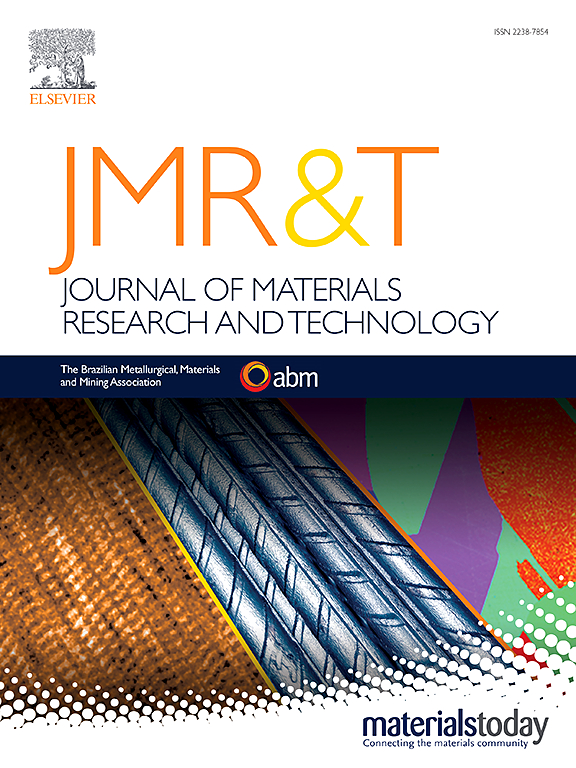Investigation on the fatigue behavior of different extreme high-speed laser cladding materials on the damaged EA4T axle
IF 6.6
2区 材料科学
Q1 MATERIALS SCIENCE, MULTIDISCIPLINARY
Journal of Materials Research and Technology-Jmr&t
Pub Date : 2025-06-09
DOI:10.1016/j.jmrt.2025.06.056
引用次数: 0
Abstract
Surface damage to railway axles intensifies with increasing axle loads and operating speeds. This study evaluates extreme high-speed laser cladding (EHLA) for repairing damaged EA4T axles using five Fe-based alloys (24CrNiMo, AISI 4340, H13, Fe314, and 316L) spanning high-, medium-, and low-alloy categories. The microstructural characteristics, phase compositions, residual stresses, hardness, and elastic modulus of the cladding layers were systematically investigated. Fatigue tests revealed that all repaired specimens exhibited reduced strength compared to smooth ones (370 MPa), primarily due to: (1) epitaxial growth forming stress-aligned coarse columnar austenitic grains, and (2) solidification defects. Among them, high-alloy claddings (316L, Fe314) retained 92–96 % fatigue strength (337–359 MPa) through their stable austenitic structure and effective stress transfer to the substrate. In contrast, medium/low-alloy claddings showed reduced strength retention (60–81 %) from stress concentration due to grain boundary weakening and elastic modulus mismatch (246–253 vs 223 GPa). These findings establish three essential criteria for laser-clad repair axle material selection: (i) austenitic phase stability to prevent deleterious phase transformations, (ii) fine equiaxed grain structure to limit columnar grain growth, and (iii) elastic modulus compatibility with the substrate to ensure optimal stress distribution.
不同极高速激光熔覆材料在损伤EA4T轴上的疲劳行为研究
随着轴载和运行速度的增加,铁路车轴表面损伤加剧。本研究评估了使用五种铁基合金(24CrNiMo、AISI 4340、H13、Fe314和316L)修复受损EA4T车轴的超高速激光熔覆(EHLA),涵盖高、中、低合金类别。系统地研究了熔覆层的显微组织特征、相组成、残余应力、硬度和弹性模量。疲劳试验表明,与光滑的试样相比,所有修复后的试样的强度都有所降低(370 MPa),主要原因是:(1)外延生长形成应力取向的粗柱状奥氏体晶粒;(2)凝固缺陷。其中,高合金包层(316L、Fe314)通过稳定的奥氏体组织和向基体有效的应力传递,保持了92 ~ 96%的疲劳强度(337 ~ 359 MPa)。相比之下,由于晶界减弱和弹性模量失配(246-253 vs 223 GPa),中/低合金包层的应力集中导致强度保持降低(60 - 81%)。这些发现为激光熔覆修复轴材料的选择建立了三个基本标准:(i)奥氏体相稳定性,以防止有害的相变;(ii)精细等轴晶粒结构,以限制柱状晶粒的生长;(iii)与基体的弹性模量相容性,以确保最佳的应力分布。
本文章由计算机程序翻译,如有差异,请以英文原文为准。
求助全文
约1分钟内获得全文
求助全文
来源期刊

Journal of Materials Research and Technology-Jmr&t
Materials Science-Metals and Alloys
CiteScore
8.80
自引率
9.40%
发文量
1877
审稿时长
35 days
期刊介绍:
The Journal of Materials Research and Technology is a publication of ABM - Brazilian Metallurgical, Materials and Mining Association - and publishes four issues per year also with a free version online (www.jmrt.com.br). The journal provides an international medium for the publication of theoretical and experimental studies related to Metallurgy, Materials and Minerals research and technology. Appropriate submissions to the Journal of Materials Research and Technology should include scientific and/or engineering factors which affect processes and products in the Metallurgy, Materials and Mining areas.
 求助内容:
求助内容: 应助结果提醒方式:
应助结果提醒方式:


